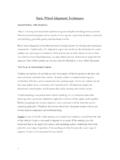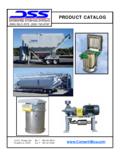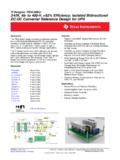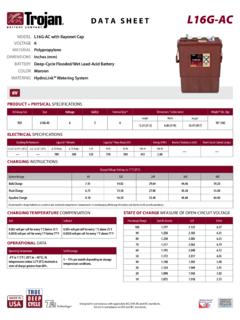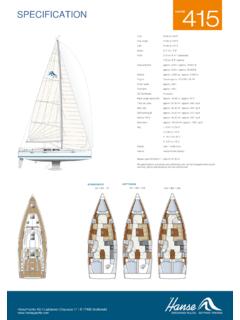Transcription of DEEP CYCLE BATTERY <Amperes-Hour (AH) Rating>
1 deep CYCLE BATTERY < amperes - hour (AH) Rating> All deep CYCLE batteries are rated in Amp-Hours (AH). An Amp- hour is one(1) amp for one(1) hour , or 10 amps for 1/10 of an hour and so forth. It is Amps multiplied (x) by Hours. For example, if you have something that draws 20 amps, and you use it for 20 minutes, then the amp-hours used would be 20 (amps) x .333 (hours), or AH. The 20 hour Rate is the accepted AH rating time period for batteries used in solar electric and backup power systems (and also for nearly all deep CYCLE batteries). This means that the BATTERY is discharged down to volts over a 20 hour period while the total actual amp-hours that it supplies are measured. Sometimes ratings at the 6 hour rate and 100 hour rate are also given for comparison and for different applications.
2 The 6 hour rate is often used for industrial batteries, as that is a typical daily duty CYCLE . Sometimes the 100 hour rate is given just to make the BATTERY look better than it really is, but it is also useful for figuring BATTERY capacity for long-term backup. amperes - hour (AH) is specified at a particular rate because of something called the Peukert Effect. The Peukert value is directly related to the internal resistance of the BATTERY . The higher the internal resistance, the higher the losses while charging and discharging, especially at higher currents. This means that the faster a BATTERY power is used (discharged), the LOWER the AH capacity. Conversely, if it is drained slower, the AH capacity is HIGHER.
3 For example, let s take a typical 100AH BATTERY . If your 12 Volt camping fridge is rated 5 Amp, it should take 20 hours to drain the BATTERY down to volts, provided the BATTERY is new and was fully charged. 5 Amp load x 20 Hours drain = 100AH required BATTERY capacity. In other words: 100AH capacity divided by 5 Amp load = 20 hour running time To convert Power (watts) in Amps: divide the Power rating by the Voltage. Example: 1000 Watt / 220V = or 60 Watt / 12 Volt = 5 Amp So your camping fridge above is rated 60watt (at 12 volt) If your entire required load is 500 Watt then it will take before the BATTERY is completely flat. 100AH / = theoretical run time. I say theoretical because in practice as the BATTERY voltage goes down the amps drawn by the load increase proportionally, so total run time will be slightly lower.
4 WARNING: This type of load is way above the rated 5 Amp for the 100AH BATTERY and will shorten its life considerably. You should not use more than 5 Amp load on a 100AH BATTERY if you want it to last as deep CYCLE batteries don t like being overloaded for long periods. To be able to supply 500 Watt equipment from 12 Volt deep CYCLE BATTERY , you will need a BATTERY bank with total capacity of (or 8 x 100AH batteries) 500W / 12V = x 20 Hours = required BATTERY capacity. This way you will be able to run your load of 500 Watt for 20 hours without damaging the batteries or considerably shortening their life because each BATTERY in your BATTERY bank of 8 will supply only Amps (which is close to the proper load rating for a 100AH BATTERY ) To sum it up: First, find your total load requirements in Watts or Amps.
5 Check your equipment manufacturer label or use the following formulas: A x V = W (Amps x Volts = Watt Power) ( 12V x 25A = 300W ) W / V = A (Watt Power / Volts = Amps) ( 100W / 12V = ) W / A = V (Watt Power / Amps = Volts) ( 60W / 5A = 12V) Second, multiply your load requirements (in Amps) by 20 to find the total BATTERY capacity needed to run this load safely. ( 5 Amp x 20 hour = 100AH BATTERY ) Here are some examples all based on 20 hour run rate: BATTERY : Load: 60AH 3 Amp 100AH 5 Amp 200AH 10 Amp 500AH 25 Amp Of coarse, you can run your 5 Amp camping fridge on a 60AH BATTERY , BUT (since you are short of 40AH BATTERY capacity) First it will only run for 12 hours or less before the BATTERY is completely flat, and Second, since the load of 5 amp your fridge is pulling, is almost twice the rated load of 3 amp for 60Ah BATTERY , expect your BATTERY life to be also shortened almost proportionally.
6 A final word on recharging deep CYCLE batteries: First, always try to recharge your batteries as soon as possible after any use. Second, try to buy a fresh BATTERY if you can in first place. i. e. buy batteries from outlets that frequently sell batteries and check the BATTERY production dates. Third, do not let the BATTERY sit unused / uncharged for long periods. Batteries discharge during storage time and this shortens their life. If possible, disconnect any load from the BATTERY while in storage or use intelligent charger for top-up. Forth, use good quality intelligent charger with at least 3 charging stages. soft start (slow charge), then bulk (fast charge), then trickle charge (maintain) Some of today s 7-stage quality chargers offer proper BATTERY maintenance and will widely increase your chances of prolonging the batteries live CYCLE .
7 Those chargers (aside from the normal charge cycles above) offer BATTERY Test & Desulphation processes which can bring a badly damaged BATTERY back to life. Using such charger takes complete care of your BATTERY maintenance ensuring long life, top performance and availability since you can also leave them connected to the BATTERY forever without fear of overcharging it. Intelligent stuff!

